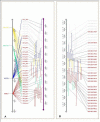A physical map of the heterozygous grapevine 'Cabernet Sauvignon' allows mapping candidate genes for disease resistance
- PMID: 18554400
- PMCID: PMC2442077
- DOI: 10.1186/1471-2229-8-66
A physical map of the heterozygous grapevine 'Cabernet Sauvignon' allows mapping candidate genes for disease resistance
Abstract
Background: Whole-genome physical maps facilitate genome sequencing, sequence assembly, mapping of candidate genes, and the design of targeted genetic markers. An automated protocol was used to construct a Vitis vinifera 'Cabernet Sauvignon' physical map. The quality of the result was addressed with regard to the effect of high heterozygosity on the accuracy of contig assembly. Its usefulness for the genome-wide mapping of genes for disease resistance, which is an important trait for grapevine, was then assessed.
Results: The physical map included 29,727 BAC clones assembled into 1,770 contigs, spanning 715,684 kbp, and corresponding to 1.5-fold the genome size. Map inflation was due to high heterozygosity, which caused either the separation of allelic BACs in two different contigs, or local mis-assembly in contigs containing BACs from the two haplotypes. Genetic markers anchored 395 contigs or 255,476 kbp to chromosomes. The fully automated assembly and anchorage procedures were validated by BAC-by-BAC blast of the end sequences against the grape genome sequence, unveiling 7.3% of chimerical contigs. The distribution across the physical map of candidate genes for non-host and host resistance, and for defence signalling pathways was then studied. NBS-LRR and RLK genes for host resistance were found in 424 contigs, 133 of them (32%) were assigned to chromosomes, on which they are mostly organised in clusters. Non-host and defence signalling genes were found in 99 contigs dispersed without a discernable pattern across the genome.
Conclusion: Despite some limitations that interfere with the correct assembly of heterozygous clones into contigs, the 'Cabernet Sauvignon' physical map is a useful and reliable intermediary step between a genetic map and the genome sequence. This tool was successfully exploited for a quick mapping of complex families of genes, and it strengthened previous clues of co-localisation of major NBS-LRR clusters and disease resistance loci in grapevine.
Figures



Similar articles
-
Genomic tools development for Aquilegia: construction of a BAC-based physical map.BMC Genomics. 2010 Nov 8;11:621. doi: 10.1186/1471-2164-11-621. BMC Genomics. 2010. PMID: 21059242 Free PMC article.
-
Physical mapping in highly heterozygous genomes: a physical contig map of the Pinot Noir grapevine cultivar.BMC Genomics. 2010 Mar 26;11:204. doi: 10.1186/1471-2164-11-204. BMC Genomics. 2010. PMID: 20346114 Free PMC article.
-
Genetic marker anchoring by six-dimensional pools for development of a soybean physical map.BMC Genomics. 2008 Jan 22;9:28. doi: 10.1186/1471-2164-9-28. BMC Genomics. 2008. PMID: 18211698 Free PMC article.
-
Old can be new again: HAPPY whole genome sequencing, mapping and assembly.Int J Biol Sci. 2009;5(4):298-303. doi: 10.7150/ijbs.5.298. Epub 2009 Apr 15. Int J Biol Sci. 2009. PMID: 19381348 Free PMC article. Review.
-
Generation of physical map contig-specific sequences.Front Genet. 2014 Jul 22;5:243. doi: 10.3389/fgene.2014.00243. eCollection 2014. Front Genet. 2014. PMID: 25101119 Free PMC article. Review.
Cited by
-
Neutral invertases in grapevine and comparative analysis with Arabidopsis, poplar and rice.Planta. 2008 Dec;229(1):129-42. doi: 10.1007/s00425-008-0815-0. Epub 2008 Sep 18. Planta. 2008. PMID: 18800225
-
Construction of a reference linkage map of Vitis amurensis and genetic mapping of Rpv8, a locus conferring resistance to grapevine downy mildew.Theor Appl Genet. 2011 Jun;123(1):43-53. doi: 10.1007/s00122-011-1565-0. Epub 2011 Mar 15. Theor Appl Genet. 2011. PMID: 21404060
-
Selective sweep at the Rpv3 locus during grapevine breeding for downy mildew resistance.Theor Appl Genet. 2012 Feb;124(2):277-86. doi: 10.1007/s00122-011-1703-8. Epub 2011 Sep 27. Theor Appl Genet. 2012. PMID: 21947344
-
Grapevine powdery mildew resistance and susceptibility loci identified on a high-resolution SNP map.Theor Appl Genet. 2014 Jan;127(1):73-84. doi: 10.1007/s00122-013-2202-x. Epub 2013 Sep 27. Theor Appl Genet. 2014. PMID: 24072208
-
A genetic map of cassava (Manihot esculenta Crantz) with integrated physical mapping of immunity-related genes.BMC Genomics. 2015 Mar 16;16(1):190. doi: 10.1186/s12864-015-1397-4. BMC Genomics. 2015. PMID: 25887443 Free PMC article.
References
-
- Jaillon O, Aury J-M, Noel B, Policriti A, Clepet C, Casagrande A, Choisne N, Aubourg S, Vitulo N, Jubin C, Vezzi A, Legeai F, Hugueney P, Dasilva C, Horner D, Mica E, Jublot D, Poulain J, Bruyere C, Billault A, Segurens B, Gouyvenoux M, Ugarte E, Cattonaro F, Anthouard V, Vico V, Del Fabbro C, Alaux M, Di Gaspero G, Dumas V, Felice N, Paillard S, Juman I, Moroldo M, Scalabrin S, Canaguier A, Le Clainche I, Malacrida G, Durand E, Pesole G, Laucou V, Chatelet P, Merdinoglu D, Delledonne M, Pezzotti M, Lecharny A, Scarpelli C, Artiguenave F, Pé E, Valle G, Morgante M, Caboche M, Adam-Blondon A-F, Weissenbach J, Quétier F, Wincker P. The grapevine genome sequence suggests ancestral hexaploidization in major angiosperm phyla. Nature. 2007;449:463–468. - PubMed
-
- Barker CL, Donald T, Pauquet J, Ratnaparkhe A, Bouquet A, Adam-Blondon A-F, Thomas MR, Dry I. Genetic and physical mapping of the grapevine powdery mildew resistance gene, Run1, using a bacterial artificial chromosome library. Theor Appl Genet. 2005;111:370–377. - PubMed
-
- Castellarin SD, Di Gaspero G, Marconi R, Nonis A, Peterlunger E, Paillard S, Adam-Blondon A-F, Testolin R. Colour variation in red grapevines (Vitis vinifera L.): genomic organisation, expression of flavonoid 3'-hydroxylase, flavonoid 3',5'-hydroxylase genes and related metabolite profiling of red cyanidin-/blue delphinidin-based anthocyanins in berry skin. BMC Genomics. 2007;7:12. - PMC - PubMed
-
- Gu YQ, Salse J, Coleman-Derr D, Dupin A, Crossman C, Lazo GR, Huo N, Belcram H, Ravel C, Charmet G, Charles M, Anderson OD, Chalhoub B. Types and rates of sequence evolution at the high-molecular-weight glutenin locus in hexaploid wheat and its ancestral genomes. Genetics. 2006;174:1493–1504. - PMC - PubMed
-
- Mozo T, Dewar K, Dunn P, Ecker JR, Fischer S, Kloska S, Lehrach H, Marra M, Martienssen R, Meier-Ewert S, Altmann T. A complete BAC-based physical map of the Arabidopsis thaliana genome. Nat Genet. 1999;22:271–275. - PubMed
MeSH terms
LinkOut - more resources
Full Text Sources
Research Materials
Miscellaneous

